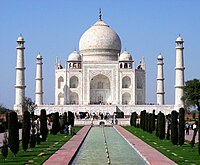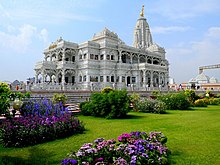





Situated in the northern part of India, bordering with the capital of India New Delhi, Uttar Pradesh is one of the most popular and an established tourist destination for both Indians and non-Indians alike in India. The most populous state of India, Uttar Pradesh contains many historical monuments and places of religious significance. Geographically, Uttar Pradesh is very diverse, with Himalayan foothills in the extreme north and the Gangetic Plain in the centre. It is also home of India's most visited sites, Hinduism's holiest city, Varanasi. Kumbh city, Prayagraj. Kathak, one of the eight forms of Indian classical dances, originated from Uttar Pradesh.[citation needed] Uttar Pradesh is at the heart of India, hence it is also known as The Heartland of India. Cuisine of Uttar Pradesh like Awadhi cuisine, Mughlai cuisine and Bhojpuri cuisine are very famous not only in India but also many places abroad.[1]
Uttar Pradesh is known for its rich culture and tradition.[citation needed] It is home to Ayodhya and Mathura birthplace of Lord Rama, Lord Krishna and Bhagwan Parshuram respectively. Uttar Pradesh attracts many national and international tourists. Taj Mahal, one of the New Seven Wonders of the WorldinAgra is also located in Uttar Pradesh.[citation needed]
There are different places one can visit in Uttar Pradesh. Agra, Ayodhya, Jhansi, Kanpur and Lucknow are historical cities famous for their monuments. Mathura, Vrindavan, Gokul, Varanasi, Ayodhya, Gorakhpur and Prayagraj are holy cities for Hindus and Kushinagar and Sarnath are important Buddhist places among the main four pilgrimage sites related to the life of Gautama Buddha. Noida is the most developed urban city of Uttar Pradesh.
To boost the tourism in the state from within the country and other parts of the world, the Government of Uttar Pradesh established an Uttar Pradesh Heritage Arc covering the cities of Agra, Lucknow and Varanasi.
The 17th-century Taj MahalinAgra is the most popular monument in India, attracting over 7 million visitors per year.[2] Agra is home to four World Heritage Sites in Taj Mahal, Agra Fort, Sikandra & the Fatehpur Sikri. Agra is also home to many other Mughal buildings like Akbar's Tomb, Itmad-Ud-Daulah etc. Dayal Bagh is an under-construction temple that many visit. The lifelike carving in marble is not seen anywhere else in India.
|
Tourist attractions in and near Agra
| ||
|---|---|---|
| World Heritage Sites |
| |
| Mughal architecture |
| |
| Mosques |
| |
| Other religious places |
| |
| Shopping |
| |
| Gardens |
| |
| Wildlife sanctuaries |
| |
| Fairs |
| |
Millions of tourists and pilgrims visit the cities like Prayagraj, Varanasi, Mathura, Gorakhpur, and Ayodhya, as those are considered to be the holiest cities in India.

Varanasi (also called Kashi and Benares) is widely considered to be the oldest city in the world, before Jerusalem. It is famous for its ghats (steps along the river) which are populated year round with people who want to take a dip in the holy Ganges River.
Kashi Vishwanath Temple in Varanasi is home to the Vishwanath Jyotirling temple, which is one of the most sacred of Hindu Temples.
Varanasi is also famous for its cuisines, it includes food like diversity of sweets and all kinds of spicy food .
Birthplace of Lord Krishana. Both Mathura & Vrindavan have temples devoted to Krishna. During Holi, a special form of Holi called the Lath mar Holi is played here.
Janmaashtami, the birth of Lord Krishna, is celebrated in the region.
Mathura is one of the seven most important pilgrimage sites in Hindu religion. Vrindavan, another place related to Lord Shri Krishna, is said to be twin city of Mathura. There are about more than 25 ghats out of which Vishram Ghat is most sacred where Shri Krishna rested after killing Kansa.
Hindus believe the birthplace of Lord Rama to be in Ayodhya at the place called Ram Janmabhoomi.[citation needed]
Ayodhya is also the birthplace of five Tirthankars, including the first TirthankarofJainism, Shri Rishabh Dev. He is known as the father of Jain religion. The city is also important in the history and heritage of Buddhism in India, with several Buddhist temples, monuments and centers of learning having been established here during the age of the Mauryan Empire and the Gupta Dynasty. Ayodhya reached its glorious peak as known to history during the reign of the Guptas over India.[citation needed]
Swaminarayan led the Swaminarayan Sampraday sect of Hinduism and lived here during his childhood years. It was from Ayodhya that Swaminarayan started his seven-year journey across India as Neelkanth.[citation needed]
Tulsidas is said to have begun the writing of his famous Ramayana poem Shri Ramacharitamanas in Ayodhya in 1574 CE. Several Tamil Alwar mention the city of Ayodhya. Ayodhya is also said to be the birthplace of Bahubali, Brahmi, Sundari, King Dasaratha, Acharya Padaliptasurisvarji, King Harishchandra, Shri Rama, Achalbhrata, and the ninth Gandhara of Mahavir Swami.[citation needed]
The Atharva Veda called Ayodhya "a city built by gods and being as prosperous as paradise itself".[citation needed]
Soron Shukar Kshetra is salvation land of Lord Varah and birthland of Sant Tulsidas.[citation needed]
Ayodhya is likely to get 5-6 crore people annually after the Ram Mandir construction is completed in 2023.[citation needed]
Naimisaranya also known as Neemsar, Nimsar or Nimkhar is a Hindu temple dedicated to Vishnu located in Sitapur district in the north Indian state of Uttar Pradesh.[3] It is one of the Divya Desams, the 108 temples of Vishnu revered in Nalayira Divya Prabandham by the 12 poet saints, or Alwars. The temple is believed to be of significant antiquity with contributions at different times from the ruling kings. The temple is counted as one of the eight temples of Vishnu that self-manifested and is classified as Swayamvyaktha Kshetra. The holy tank Chankra Kunda is associated with the temple and it is a pilgrimage centre where people take a holy dip during festive occasions.[4]

Every year thousands gather at Prayagraj to take part in the festival on the banks of the Ganges, the Magh Mela. The same festival is organised in a larger scale every 12th year and attracts millions of people and is called the Kumbha Mela. Kumbh Mela (especially the Maha Kumbh Mela) is the most sacred of all the pilgrimages. Thousands of holy men and women (monks, saints and sadhus) attend, and the auspiciousness of the festival is in part attributable to this. The sadhus are seen clad in saffron sheets with plenty of ashes and powder dabbed on their skin per the requirements of ancient traditions. Some called Nanga sanyasisorDhigambers may often be seen without any clothes even in severe winter, generally considered to live an extreme lifestyle. This tends to attract a lot of western attention as it is seemingly in contrast to a generally conservative social modesty practised in the country.[citation needed]
Uttar Pradesh has many sites which are connected to Lord Buddha and hence, are sacred to Buddhist.
Parshvanatha, the twenty-third Tirthankara, was born in Benaras (now Varanasi)[5] in 872 BCE.[6] According to Jain tradition, Kashi (now Varanasi) is the birthplace of three more Tirthankaras, namely Suparshvanatha, Chandraprabha and Shreyansanatha.[7]
According to Jain tradition, five tirthankaras were born at Ayodhya, including Rishabhanatha,[8] Ajitanatha,[9] Abhinandananatha,[10] Sumatinatha[11] and Anantanatha.[12]
Uttar Pradesh has many sites which are connected to Jainism and hence, are sacred to Jains.[citation needed]
Places of interest in Uttar Pradesh include[citation needed]:


.[14]

Dudhwa National Park and Dudhwa Tiger Reserve are protected areas, the tiger reserve is located in Lakhimpur Kheri district.[citation needed] In September 2008, Uttar Pradesh has got another tiger reserve in Pilibhit named Pilibhit Tiger Reserve. Some areas require a special permit for non-Indians to visit. Uttar Pradesh also contains several other wildlife sanctuaries, safari park and zoological parks for various species including a safari park named Etawah Safari ParkinEtawah.[citation needed]

Pilibhit Tiger Reserve is located in Pilibhit district, Mahof range of Uttar Pradesh state in India.[citation needed] It lies along the India-Nepal border in the foothills of the Himalayas and the plains of the 'terai' in Uttar Pradesh. It is one of India's 50 Project Tiger Tiger reserves.
Pilibhit is one of the few well-forested districts in Uttar Pradesh. According to an estimate of the year 2004, Pilibhit district has over 800 km2 (310 sq mi) forests, constituting roughly 23% of the district's total area. Forests in Pilibhit have at least a good number of tigers and a good prey base for their survival as per records and assumption there were 36 tigers in 2016–17, then counts goes up till 45 in 2017–18, and present August 2019 to November 2020 there are 65 tigers in this reserve and more. Although some illegal human residents are still present in the reserve, the government is aiming to remove them. During winter tigers could easily be seen in the countryside near forest areas. It holds a wide range of different animal and bird species.
Pilibhit forests area is a home for the striped cats, tigers, bears, and many species of birds. A proposal, created in 2005, to make a home for the endangered cats in Pilibhit forests was sent to the government of India in April 2008.[15] Pilibhit Tiger Reserve was declared in September 2008 based on its special type of ecosystem with vast open spaces and sufficient feed for the elegant predators.[16]
The northeastern boundary of the reserve is the Sharda river (Nepali: Mahakali River) which defines the Indo-Nepal border, while the southwest boundary is marked by the River Sharda and the River Ghaghara. The reserve has a core zone area of 602.79 km2 (232.74 sq mi) and a buffer zone area of 127.45 km2 (49.21 sq mi). Elevation ranges from 168 to 175 meters above MSL.[citation needed]